Okay, so, we left off last time and, frankly, things were looking up for queer people in comic books, right? All the major comic book publishers were telling stories about LGBTQ+ people, they’d not shied away from talking about the AIDS crisis and other issues that were important to the queer community. So things are looking up right? Well buckle up, this ride is about to get bumpy.
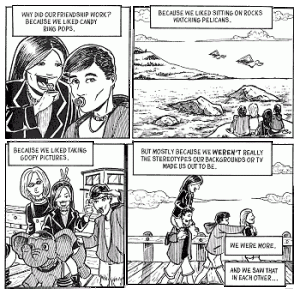
There’s a pretty strong start to these years — Judd Winick created the non-fiction graphic novel Pedro and Me: Friendship, Loss, and What I Learned about his friendship with AIDS activist Pedro Zamora, a friendship spawned by their time together on The Real World: San Francisco. The work would go on to be nominated for a Pulitzer Prize and actually win eleven other awards including the GLAAD Outstanding Comic Book Media Award and the Robert F. Sibert Informational Book Honor Award.
Dark Horse Comics had begun publishing comic books telling additional Buffy the Vampire Slayer and Angel stories. Willow Rosenberg and Tara Maclay appeared in both series of comics, beginning in 2001, giving some much needed lesbian representation to the brand.
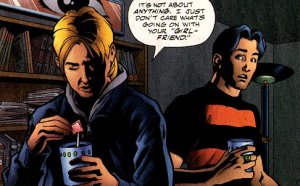
DC apparently did not take well to not getting the Outstanding Comic Book award, as the following year in Green Lantern (vol 3) #137 Kyle Rayner’s assistant Terry Berg came out of the closet. The book did earn DC another Outstanding Comic Book award from GLAAD. (Green Lantern would actually win it two years in row, after Terry survives a brutal hate crime in issue #154.) DC also published an arc in their American Century series about the Red Scare, and how it ended up being wielded against the gay community. This didn’t end up winning any awards, but it is a pretty insightful piece on an often overlooked aspect of that part of US history.
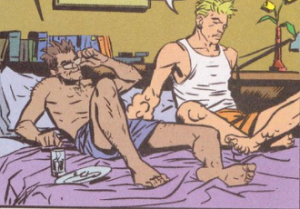
Shortly after finally officially confirming that Mystique and Destiny were lovers in X-Treme X-Men #1, Marvel handed off the reigns of their series X-Force to Peter Milligan, who created a number of queer characters including Bloke, who died pretty much right away, and Vivisector and Phat who pretended to be in a relationship for media attention and then both realized they were actually gay in a storyline that carried through 2002. When X-Force was cancelled, they were introduced in the new X-Statix series to continue that plotline. In fact, 2002 was a pretty gay year for Marvel all around. In Citizen V and the V Battalion, they revealed that “best friends” Roger Aubrey and Brian Falsworth — classic heroes from the 1970s, the latter of whom had died in 1981 — were actually lovers. Retroactively, that made them Marvel’s first gay characters. Meanwhile, Moondragon began a romantic relationship with her female roomie Marlo — which means that old storyline about Cloud turning into a man because they were in love with Moondragon is actually even worse than we knew, but clearly Marvel has put in a lot of effort to move past that. Meanwhile, Image Comics was busily churning out Age of Bronze, a comic book retelling of the Trojan War, which included Achilles and Patroklus, and it did not make any effort to straightwash them.
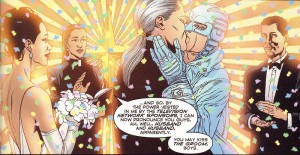
In 2002, DC introduced a superhero team designed like a law firm, the Power Company led by Josiah Powers, who also had a relatively quiet domestic life with his partner Rupert. Meanwhile, in Hellblazer #173 John Constantine actually landed a boyfriend named Stanley Manor. Like all of Constantine’s relationships, it ends badly (in the very next issue). But we have much, much, much bigger news to cover in topic of “gay things DC published in 2002.” On July 1, 2002 The Authority #29 was released….after the team defeated their latest “big bad,” Midnighter and Apollo got married! Not only is it super sweet in a way that’s kind of weird for that particular series, it also has the distinct honor of being the first same-sex marriage in mainstream comic book history.
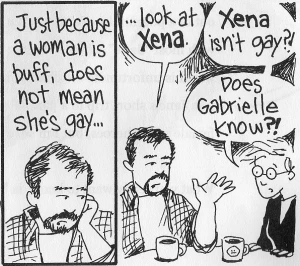
Much like the Comics Code Authority, underground comix were fading out as well — partially because distribution had changed in the 90’s, and it was easier to have things published “above ground” so to speak. Paige Braddock had been publishing Jane’s World independently for some time, but in 2002 she started her company Girl Twirl Comics primarily to get her work more widely distributed. It worked. Also, by now, a lot of self-published or independently published comics were just being distributed as online comics — like the online strip Young Bottoms in Love which began in 2002 as well. It was an anthology strip collecting a lot of creator’s work, edited primarily by Tim Fish (who also did a lot of the artwork).
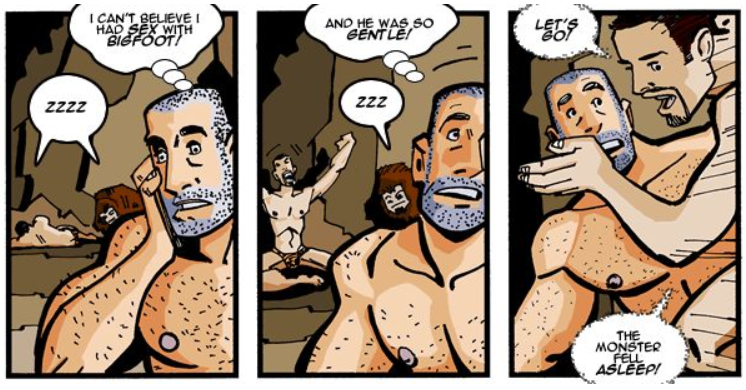
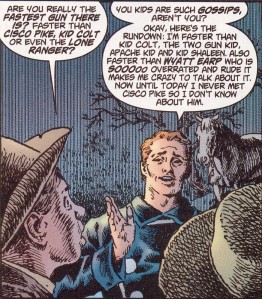
In 2003, Marvel began releasing a sort of reimagined Rawhide Kid miniseries, which was an Old West comic series that originally debuted in 1955, produced by the now defunct Atlas Comics. Marvel had taken over the series in the 60’s, and turned him into a soft-spoken but energetic gunslinger from a fairly standard wild west action hero and then left the title abandoned for a while. With the new series, Marvel decided to add one more characteristic to set the hero apart from other heroes of the genre: they made the Rawhide Kid gay. Although they definitely played off of stereotypes for laughs, the presentation was generally applauded for its positive portrayal of a gay man in a genre that we really hadn’t been part of before. (I’m not entirely sure we’ve been a part of it since, to be honest.)
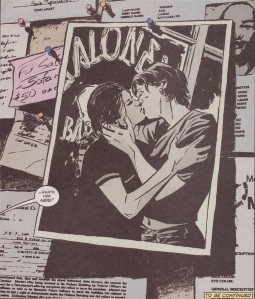
Other than continuing the aforementioned storyline between Phat and Vivisector, Marvel really only dabbled a bit in other LGBTQ+ stories in that year — revealing that the Black Cat was bisexual, and having the Punisher have some dealings with a gay sheriff. It was also kind of a quiet year for DC, aside from the aforementioned hate crime story in Green Lantern, though they also gave Dick Grayson (the most objectified man in comic books) a story pretending to be the romantic partner of his police partner Gannon Malloy to protect him from homophobic harassment from other cops. The more stunning moment was in the pages of Gotham Central #6 — the last panel of which showed a picture of Renee Montoya kissing a woman, outing her as a lesbian to the rest of the precinct. The story would continue on for several issues, revealing it was done by an old enemy, Marty Lipari, as part of an even larger scheme by Two-Face. (Renee, interestingly, is the first of the characters created in Batman: The Animated Series to make their way into the comics and end up an iconic queer character. Not the last though!) There’s also a neat juxtaposition when compared to the Dick Grayson storyline, since Renee’s captain on the force is none other than Maggie Sawyer so she had a lot more support than Gannon Malloy did.
One other pretty big thing that happened in that year was the formation of Prism Comics, which is a non-profit organization to help LGBTQ+ comic creators network, and to spread information and increase availability of LGBTQ+-related comics. They do a lot of panels at conventions like San Diego Comic Con and New York Comic Con. They also award the Prism Comics Queer Press Grant to an aspiring comic creator every year. And their web site was also one place I got a fair amount of the information that I’ve been presenting to you over this whole series of posts, so you should probably check it out.
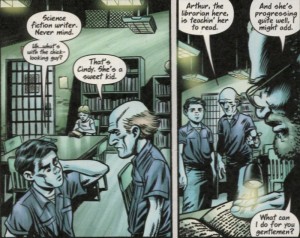
In 2004, DC tried launching an imprint called “DC Focus” that wasn’t going to tell superhero stories. It didn’t sell, but one of their series — Hard Time — was about a men’s prison. One of the inmates was actually a transgender woman named Cindy Crane. While her placement in the prison suggests that she’s been misgendered by the system, the inmates all treat her and refer to her consistently as a woman. Also, in the Vertigo imprint’s series Y: The Last Man they revealed that one of their three leading characters, Dr. Allison Mann was not just queer but also real sassy about it.

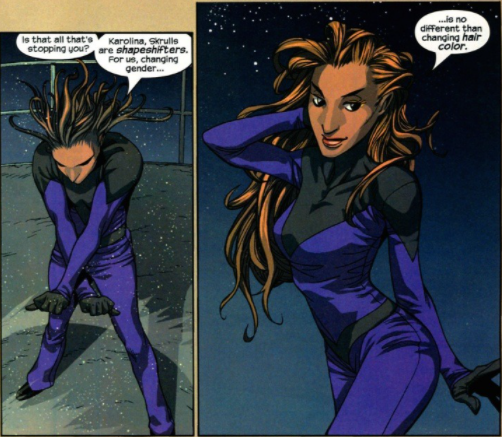
Meanwhile, Marvel was starting to dabble with making some of their classic X-Men characters queer — they made Angel gay in an alternate universe set in the year 1602, and set the stage for a romantic relationship between Northstar (who, I guess, is gay in every universe) and Colossus in their Ultimate Universe. They also created the, as far as I know, first ever pansexual superhero in the shapeshifting genderfluid Xavin in Runaways (vol 2) #7. (Runaways in general is a pretty queer series, with two of the major characters being lesbian and literal rainbow Karolina Dean and bisexual witch Nico Minoru.) But maybe the most memorable thing that Marvel did was in 2005 — which was to re-introduce us to Billy Kaplan, better known as Wiccan. I say “re-introduce” because his history with Marvel goes back to 1986 but he wasn’t actually real, and then he died….it’s a long story. But it would have to be when your mother is Scarlet Witch and your dad is Vision. Anyways, his reintroduction was in Young Avengers #1 and by Young Avengers #6 he was in a romantic relationship with his teammate Hulkling. While at the time this was just adding two new gay characters to their existing repertoire, they rapidly became fan favorites, and their inclusion earned Young Avengers the 2006 Outstanding Comic Book award from GLAAD, and also got them a Harvey Award for Best New Series.
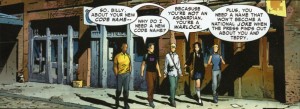
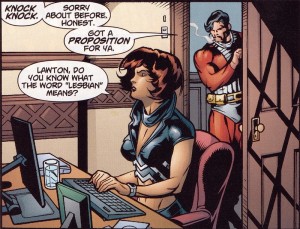
DC dove hard into its sassy lesbian thing that it had begun with Allison Mann, by revealing Scandal Savage was a lesbian in a relationship with fellow supervillain and teammate Knockout. The following year, in their 52 series they brought back a new incarnation of an old character: Katherine “Kate” Kane. While the previous Batwoman had been established pretty much solely to prove how straight Bruce Wayne was, this Kate Kane was like….almost an apology to the queer community for erasing us during the decades they followed the Code. While they didn’t give too much information about Kate all at once, one of the very first things they revealed was that she was Renee Montoya’s ex-girlfriend, but eventually as her backstory was revealed readers learned that Kate was an out and proud lesbian who’d been booted from the military thanks to Don’t Ask, Don’t Tell. And unlike the previous Batwoman, this Batwoman was a very independent superhero who seldom crosses over with others — even Batman only worked with her a handful of times.
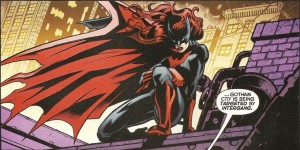
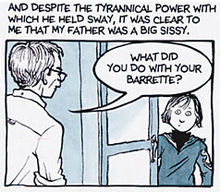
That was the same year, by the way, that Alison Bechdel released her autobiographical comic Fun Home: A Family Tragicomic which focused on her relationship with her closeted father. The graphic novel was critically acclaimed, being officially listed as one of the best books of 2006 by The New York Times, The Times, Publisher’s Weekly and Amazon. Entertainment Weekly said it was the best non-fiction book of the year, but Time said it was the best book of the year, period. It was nominated for a whole mess of awards I won’t even list, but it won the GLAAD Media Award for Outstanding Comic Book, the Eisner Award for Best Reality-Based Work, the Stonewall Book Award for non-fiction, the Publishing Triangle-Judy Grahn Nonfiction Award, and the Lambda Literary Award in the Lesbian Memoir and Biography category. It got turned into a musical, which launched off-Broadway in 2013 and has also won and been nominated for a ton of awards. And the praise and attention have barely slowed down since — in 2019, The Guardian placed Fun Home at #33 in its list of the 100 best books of 21st century. Most mainstream comics about straight people can’t even garner that much attention, and this was getting noticed by everyone, from comic book fans to literary academics. So, when I say that Fun Home is an important piece of LGBTQ+ history and culture….believe me, and go read it or see it on stage. Or better yet, read it and then see it on stage.
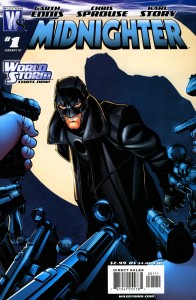
I guess everyone was pretty lesbian-ed out after 2006, though, because barely anything happened with queer women in comics the following year. However, Midnighter got his own series by DC’s WildStorm imprint at the very beginning of 2007 which focused heavily on his relationship with Apollo and with their adopted daughter. It was the first mainstream series with a queer character’s name as the title, the first mainstream solo superhero series with a queer lead, and the first mainstream series with a gay man as the lead. (Well, okay, technically, Northstar had gotten his own miniseries in 1994, but it completely ignored his sexuality which is why I ignored it. And I stand by that decision.) So, y’know, kind of a big deal. Apparently this gave publisher’s the idea that queer characters could be strong enough to be leads in their own right — the end of the following year Top Cow Comics released a story arc in Witchblade wherein the lead, Danielle Baptiste, would question her sexuality and begin a relationship with her roommate Finch. IDW Publishing confirmed the homosexuality of Duncan Locke in Locke & Key – Head Games #4 only four months later. As far as I can tell, those were the first queer characters for either of those companies and both of them are leading characters.
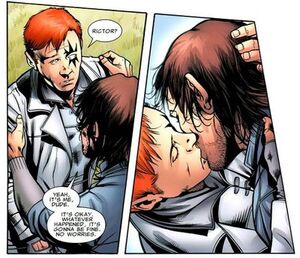
Marvel even decided, by 2009, that it might just be time to make some of their longstanding X-Men characters actually be queer in their primary universe, instead of just in alternate ones. In June, they introduced Kyle Jinadu, who is (I believe) main continuity’s Northstar’s first ever actual boyfriend since he came out of the closet over a decade prior! X-Factor (vol 3) #45 featured the first kiss between characters Rictor (who’d been introduced in 1987) and Shatterstar (who’d been introduced in 1991). I’d like to say this made a big splash — I have been a fan Shatterstar specifically since about 1991, so I was certainly charmed. but it simply couldn’t compete with what DC was doing with their queer characters that year.
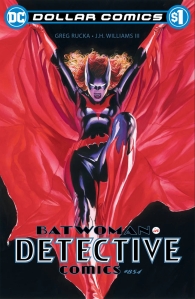
At literally the same time as that kiss, Kate Kane made waves again by taking the leading in Detective Comics. That’s big because Detective Comics is one of — if not the — longest running comic book series in history. And it’s still going after launching in 1937. It was literally the series that founded DC Comics. (DC is short for Detective Comics — which makes the company’s name actually Detective Comics Comics if you think about it.) It was an anthology series for a while, until they introduced Batman in 1939 in issue #27 (which is the most valuable comic book in history) and he was essentially the star of the series after that. For seventy years and 827 issues. In 2009, the series took a brief hiatus for three months because of various other story arcs going on with the Bat family, and then they released issue #854, with Batwoman taking the lead. There was also a ten page back up strip featuring Renee Montoya, who was now the superhero known as the Question. So, yeah, they took essentially the most important series in DC Comics and handed it over entirely to lesbian characters. Batwoman remained the lead until issue #863.
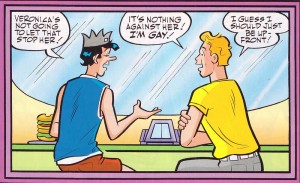
In 2010, one of the last major American comic book producers finally introduced its very first LGBTQ+ character. That would be Archie Comics, who finally gave us Kevin Keller in Veronica #202. I gotta be honest, I can’t tell you too much about him. I don’t read Archie Comics much. But, in 2012 — just two years later — in Life with Archie #16, which is a sort of flashforward to adulthood series — Kevin Keller got married in the second same-sex marriage in mainstream comics. (Except for a nameless gay couple getting married in Ex Machina #10, technically they were second. But they didn’t have names.) Kevin, and his husband Clay Walker, also had the first same-sex interracial marriage in mainstream comics. So, they may have gotten a slow start with queer characters, but they really decided to jump in and go straight to doing something that Marvel comics had still not done. That issue, by the way, was boycotted by the One Million Moms because it was sold in Toys’R’Us stores which led to the comic completely selling out, and subsequently inspiring Kevin to get three solo comic book series. Thanks One Million Moms!
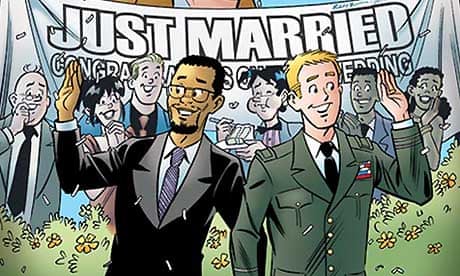
As a side note, the Comics Code Authority — which had ben increasingly irrelevant has it was abandoned by publisher after publisher, some of whom were adopting a ratings system that Marvel had created essentially out of spite when the CCA had demanded changes to an X-Force story in 2001. DC Comics, which was only submitting some stories to the CCA by this point, announced they were completely discontinuing use of the CCA on January 20, 2011. That left Archie Comics as the only publisher still using the CCA….for exactly one day before they also announced they were stopping that practice. So that was, at long last, the end of that.
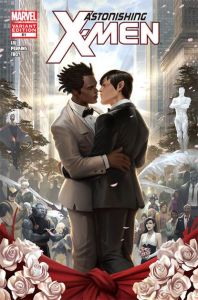
Anyways, it was only a matter of months after Kevin Keller’s wedding when Marvel would go ahead and have their first same-sex marriage. Although Wiccan and Hulkling got engaged first (in Avengers: The Children’s Crusade #9 — also their first depicted kiss), the first wedding would actually be between Northstar and Kyle Jinadu. Here’s the thing, and maybe it’s because I was mostly a Marvel fan at the time, or maybe I’m having some Mandela effect thing, but I really recall Marvel advertising Astonishing X-Men (vol 3) #51 as being the first gay marriage in comic books. They sent out “Save the Date” cards. They made it a really big deal. And I can give them a pass on not including anything from underground comix but…really, they were third (or fourth, depending on if we’re counting that nameless couple in Ex Machina.) They didn’t even manage to have the first interracial same-sex wedding. Still, it was a first for Marvel and for Marvel fans and specifically Northstar fans, this was pretty exciting and it was very cool that Marvel made an extremely big deal about the fact it was happening. They had like….basically every superhero that had ever been in any comic book Northstar was ever in appear, or at least show up on the cover. (I’m not even sure if Kyle actually had any guests at the wedding, just all Northstar’s superfriends.) This was such a big deal, the original proposal for the splash cover art sold on eBay for more than $2,100.
Also by Marvel, and I’m including it here solely because the second panel is so great, in Avengers Academy #23, the character Striker came out to his bisexual teammate Lightspeed. Just look at her face. (And in case you weren’t convinced about how very LGBTQ+ this all is, Lightspeed’s superpower involves leaving a rainbow behind her when she flies.)
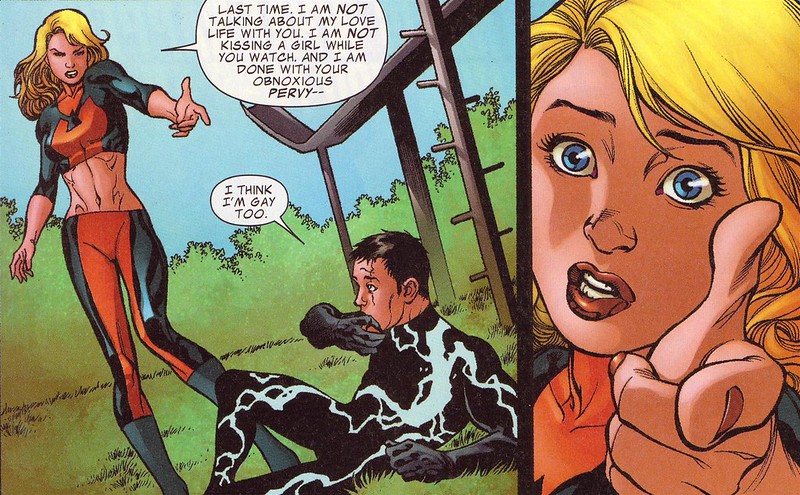
So, you may be wondering, what was DC doing right about now? Right? Well, as it turns out, rebooting their entire continuity. Okay, technically that began in 2011 but this is like a whole thing to talk about so I wanted to get those marriages out of the way first. So, basically, DC does this every once in a while where they kind of “start over” their whole universe, and this time in 2011 they also merged it with some of their offshoot imprints like WildStorm and some of their Milestone and Vertigo content. This led to some good stuff for queer people in comic books….and it also led to some bad stuff. I’m going to dissect that in entirely too much detail for you right now.
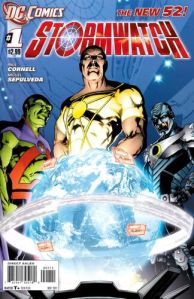
So, to start with, part of this “The New 52” branding they were doing as they reset the continuity was that they were launching with only 52 series to like establish their remade universe. (And to be clear, “resetting” doesn’t mean, in this case, erasing all of the history of every character and starting from scratch. A lot of important and memorably storylines and moments were kept as part of their character’s backstory – like they did not retell Batman’s origin story.) One of the first of these series was Stormwatch — starring, among a handful of others, Midnighter and Apollo. Unfortunately when they decided to reset the continuity….DC also decided to drop their wedding from their history, they’re just dating. It’s fine, it’s not like that was a major moment in their character’s histories and also an important moment in LGBTQ+ comic history… And for the record, as of my writing this in 2021, they still have not married again. (Maybe that’s why Marvel advertised Northstar and Kyle’s wedding the way they did, since DC had already been like “no wait, that never happened.”)
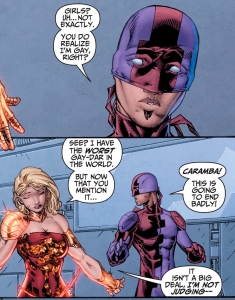
The next week after launching that series, they launched Batwoman (vol 2) — a permanent solo series, not miniseries like volume 1 had been, all about Kate Kane who remained pretty much exactly as she was prior to the reset. This series also included Maggie Sawyer, with whom Kate begins a relationship. Two weeks after that, the new Teen Titans series began which would quickly introduce Bunker, a gay Latino character, as one of their team members. That was released roughly the same time as Justice League Dark which brought back John Constantine. So they relaunched with four series, pretty much right off the bat, featuring LGB characters in leading roles. And that’s it — that’s the good news. Pretty much none of their otherwise established queer characters were anywhere to be found until 2012, when they brought back the Pied Piper, and in their series about Earth 2 (which is an alternature universe) they did reveal that the Green Lantern Alan Scott was gay. But, if you were noticing, there’s still a demographic that was completely missing: they now had no transgender characters. At all. And only one of their LGB characters wasn’t white. So what I’m saying is, it kinda seems like a backslide, right?
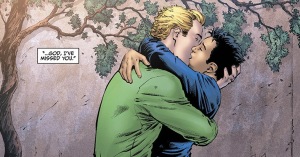
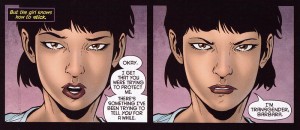
In fact, there wouldn’t be a transgender character in DC Comics at all until Batgirl #19 in 2013, when Barbara Gordon’s roommate Alysia Yeoh came out. She was a minor character, and was both a lesbian and transgender, as well as being Asian. DC apparently thought this scored them major diversity points (I guess it actually kind of did) and so they went on to advertise her as their first ever transgender character….despite the fact that they’d previously had a whole bunch like Coagula, Lord Fanny, and Shvaughn Erin. As a side note, this was about the time DC’s character Tremor stated she was asexual in The Movement (vol 1) #10 — something that I believe was actually a first, because I can’t find any other superhero (or even comic book character) who had claimed that identity for themselves before that.
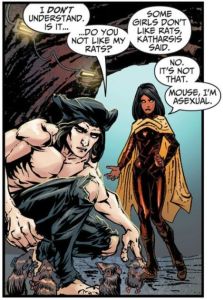
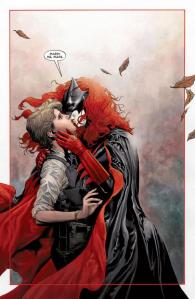
2013 was also the year that Kate Kane and Maggie Sawyer got engaged — exciting! The first mainstream same-sex marriage between two women! But DC co-publisher Dan DiDio pulled the plug on that plotline, causing enough of a stir that Batwoman writers J.H. Williams III and W. Haden Blackman quit the series. DC’s public explanation was, essentially, that superheroes can’t get married so their books don’t end up being about their marriages. While there’s a certain argument there that I can follow, it was pretty gross to cancel that same-sex marriage in comics so soon after retconning out the first same-sex marriage. (It looks even worse when you consider that married heterosexual heroes Adam and Alanna Strange were introduced in Justice League United #0 the very next year.) Like I said, a backslide.
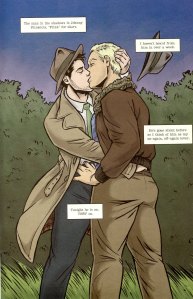
Fortunately, DC wasn’t the only comic book game in town. Houghton Mifflin Harcourt published Nicole George‘s memoirs in comic book form with Calling Dr. Laura. Image Comics gave us Betty — essentially a queer gnome — in their new fantasy adventure series Rat Queens. The following year, Fantagraphics published Julio’s Day — a story that follows a fictional, closeted Mexican-American man and his family for 100 years. Parts of it had been published previously, but the story had never been completed until this. Shortly after that, Northwest Press began their 1940’s noir series Dash — the main character of which was gay private eye Dash Malone. Hill and Wang finished up 2014 by releasing Second Avenue Caper, based on a true story of a group of friends illegally importing experimental HIV medicines from Mexico during the beginning of the AIDS crisis.
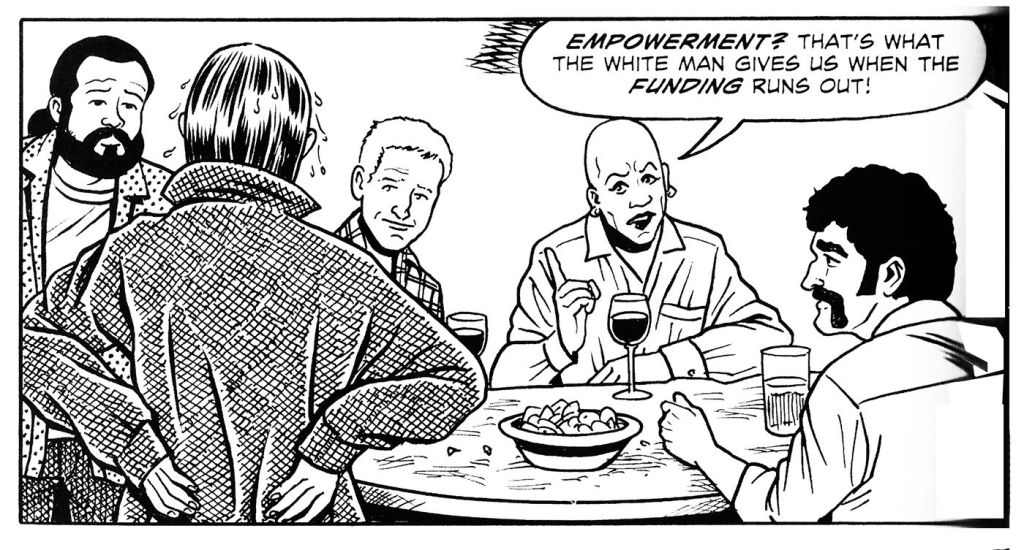

That year, DC gave us the first glimpses of an extremely open romantic relationship between longstanding Batman villain Poison Ivy and Harley Quinn — a villain imported to the comic books from Batman: The Animated Series (just like Renee Montoya was!) in the pages of Harley Quinn (vol 2). In 2015, Barbara Gordon (Batgirl) got a new roommate after Alysia moved out to live with her new girlfriend. This new roommate, Frankie Charles, was openly bisexual. If it seems like Batgirl is going to be the salvation of DC Comics though — guess again! Just two issues later, they’d kick up a whole mess of controversy by giving us a story in which a guy dressed up as Batgirl and attempted to replace her. It seemed to play off the deeply inaccurate and offensive idea, often trotted out anytime one of those “bathroom bills” gets proposed by conservative politicians, of men dressing as women to commit crimes. In the end, the creators of the story apologized for the story. Just a few issues later Alysia Yeoh would get married to her girlfriend Jo Muñoz in the pages of Batgirl (vol 4) #45 — marking the first same-sex wedding in the new DC continuity, between two minor characters in a book that is almost entirely focused on Barbara Gordon’s relationship with Dick Grayson. If that sounds like I’m judgey and bitter, like when I talk about it I’m thinking about how great a Maggie Sawyer/Kate Kane wedding would have been and it would hav focused on the people actually getting married….well, there’s a reason for that. (The reason being that I’m judgey and bitter.)
I have to be honest. This is pretty much where the sources I’ve been using stop. But a lot has happened in the past few years, so there’s more to tell. So I’m going to go off of my very fallible memory. Like, I’m going to research the things I remember, but like…if I don’t remember that it happened, it’s going to be tough for me to research. And I pretty much only read DC and Marvel so….I’m sure other publishers had things they did. I just don’t really know what it was. So, there’s going to be probably a lot of things I’m missing. (Not that I covered literally every moment before this, either.) If you know of something that I’m missing (or something that got skipped over even before this in the series), please leave a comment about it and let us all know!
Anyways, 2015 was also the year we sort of kind of got second ever pansexual superhero. Supervillain? Depends on the day. That would be Marvel’s Deadpool. Deadpool himself, of course, had been around since 1991. And he’d been flirting with, y’know, everyone since pretty much that time. And it had been said before by Deadpool writers that his type was “anyone with a pulse” but in 2015 was the first time his sexuality was actually given a label — on Twitter, when writer Gail Simone confirmed that she had “always thought of Deadpool as pansexual.” Granted, in the actual pages of comics, Deadpool’s love interests have always been women or female-presenting cosmic entities. But that hasn’t stopped him from flirting with well, basically everyone but most especially Spider-Man and Wolverine. And Cable. And Colossus. And Thor. And….yeah, everyone.
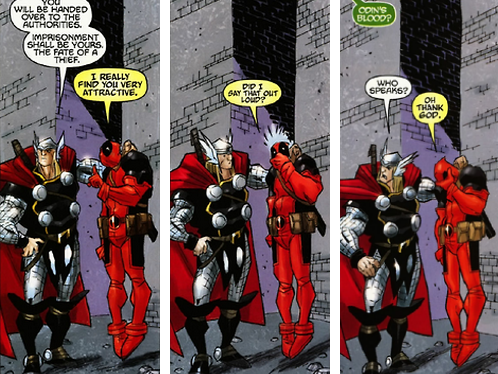
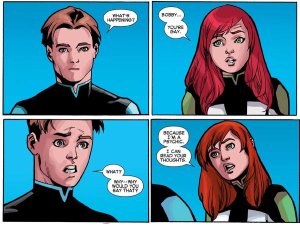
This was the same year that Marvel went fully into their “make a classic X-Men gay” thing they’d dabbled in with alternate universes before. This time, they picked Iceman. They’d hinted, once, kind of obtusely, that he wasn’t straight back in 1994 and then completely dropped it ever after. In 2015, they had the original X-Men team — as teenagers — brought forward in time which led to a lot of confusion when you’re trying to tell someone about what plotlines were happening, so bear with me. Jean Grey telepathically learned that Iceman was gay, and told him so. This led teen Iceman to ask a very good question: “how can my older self not be, but I am?” And, honestly, LGBTQ+ readers like myself were kind of nervous about what Marvel was getting at. In November of that year we actually found out, when teenage Iceman confronted adult Iceman and adult Iceman finally came out in the first issue of his own series, Iceman #1. Honestly, it’s a pretty great scene but it’s kind of important because it’s Marvel’s first queer-led solo series. But it was also a game changer in that Iceman had been a main character in their comic books since 1963, one of the original five X-Men. And, frankly, it was seamless, it made perfect sense with the decades of character development he’d had — given that his parents had been portrayed as ultra-conservative that whole time. Five issues later, Iceman told his parents he was gay… and it didn’t go well. (This all, once again, retroactively changed who Marvel’s first gay character was!)
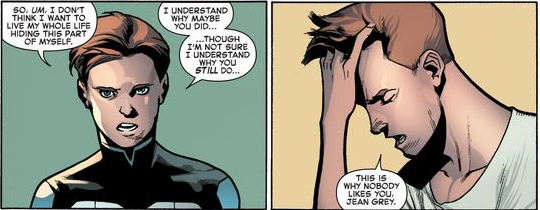
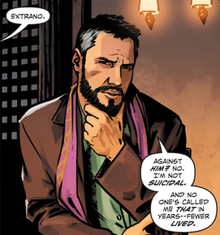
Speaking of first gay characters, DC made a bold move in 2016 by bringing a completely reenvisioned Extraño back into the picture in Midnighter & Apollo (vol 1). This was actually an incredible move on their part — no longer the flamboyant mashup of offensive stereotypes, now he chose to go exclusively by his real name Gregorio de la Vega, and was a much more serious and in many ways jaded sorcerer. But! He was married to Tasmanian Devil — the first member of the Justice League to come out! And despite the fact that I don’t think they ever interacted, I somehow feel like that’s perfect. Anyways, Midnighter & Apollo needed a character with mystical powers for the story arc they were telling and they could very easily have gone with anybody. Even if they specifically wanted a queer one, Constantine would have been an obvious choice. But the writers decided they wanted to bring more queer people into the new continuity — something desperately needed — so they dipped into DC’s history and brought us some. Aside from his appearances in that series, Gregorio has since shown up in issues of Justice League and Justice League Dark.
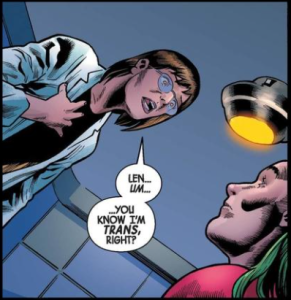
Over the next few years, Marvel would introduce a bunch of LGBTQ+ characters. None of them come to mind as being especially noteworthy, but I’ll highlight a few. First, from Marvel: former Dora Milaje (who MCU fans should be familiar with) soldiers Ayo and Aneka abandoned their positions in 2016’s Black Panther: World of Wakanda #1 to join together both as lesbian lovers and freedom fighters. In 2017, America Chavez would become Marvel’s first queer woman to lead a solo series in America, which also explained her backstory as being from an entirely female alternate reality. In 2018, we were introduced to Darnell Wade — a mutant with teleportation powers and also an NYC drag queen who became one of the X-Men and would go on to emcee Iceman’s birthday celebration — and Dr. Charlene McGowan — a transgender woman whose skills as a scientist have made her an invaluable ally to the Hulk. The book’s creators brought in Crystal Frasier to help make sure they had an authentic trans voice behind the character. The next year, Mystique and Destiny were confirmed to have gotten married at some point “offscreen.”
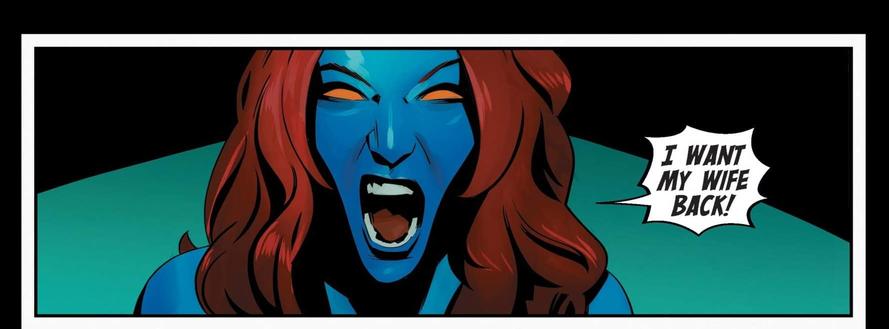
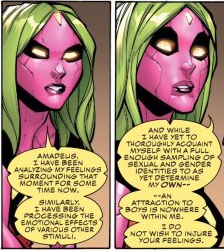
In 2019, there was confirmation — first on Twitter and then in the X-Factor and Lords of Empyre books — that Tommy Shepherd, aka Speed, Scarlet Witch and Vision’s other reincarnated kid, was bisexual, and recently has been dating X-Factor’s Prodigy. Speaking of X-Factor, this latest incarnation of the team is led by none other than Northstar which, if I’m not mistaken, makes him the first queer superhero to officially be a team leader. Also, back to discussing Scarlet Witch and Vision’s kids, Vision made a daughter with a robot named Virginia who was programmed with Scarlet Witch’s brainwaves, right? That daughter, named Vivian, declared in 2019 that while she hadn’t fully explored what her sexuality might be that she was absolutely not attracted to boys. She later followed that up by kissing her female teammate Ironheart. That’s three for three on Vision and Scarlet Witch having queer kids. (They’ve have other kids who’ve all died before their sexualities were explored at all. So we can just assume they must’ve been queer too.) Get those two to a PFLAG meeting asap. If they needed to have a straight child to save the world, that would be the end. I love them. And Billy and Hulkling — who, remember, got engaged in 2010 even before Northstar did — finally actually tied the knot in 2020. Just a ten year engagement. (The reason I’m focusing on these kids is because WandaVision was the impetus for me writing this whole series.)
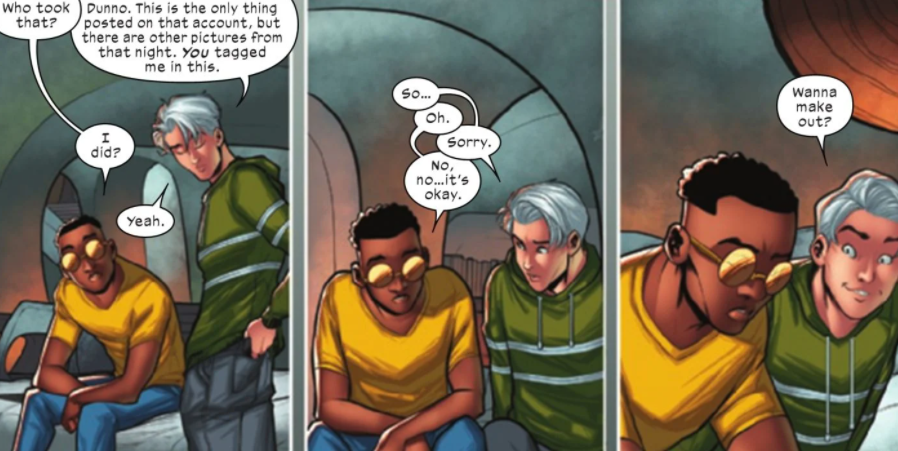
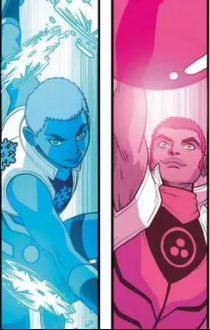
Not everything Marvel has decided to do has been great, or met without controversy. They announced the introduction of their first non-binary superhero in a sibling duo featuring the non-binary Snowflake and their twin brother Safespace. And, like, okay, I get what Marvel was trying to do by kind of reclaiming those terms that are often used to disparage liberals. But doing that with what you’re advertising as your first non-binary character? There was TONS of criticism that it actually implied that non-binary people were the oversensitive types of people the term “snowflake” is often meant to attack. The book they were supposed to be in has yet to appear, and might have been cancelled. Thing is….they also are not the first non-binary character Marvel’s had. This year they quietly introduced two character named Cam and Monica Sellers, two young mutants who identify as non-binary. Minor characters I’ll grant you, but they exist. Not to mention that a lot of the shapeshifters in the Marvel universe — Xavin, Mystique, Loki, etc — are pretty clearly genderfluid, and have been for a long time.
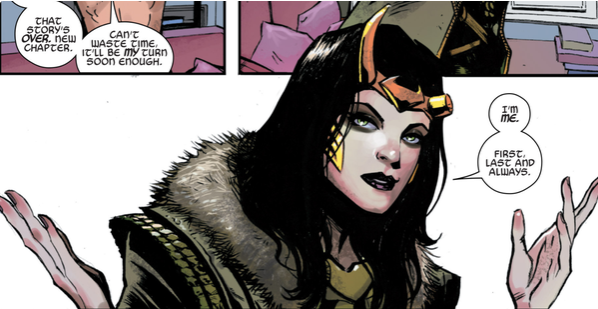
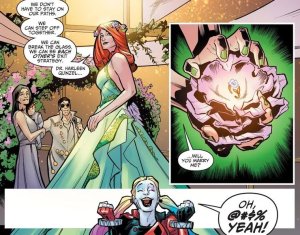
While Marvel was finally diving into introducing plenty of LGBTQ+ characters, DC was actually focusing more on the already established queer characters. I mean, they definitely introduced new ones too, don’t get me wrong. But the highlights, for me at least, were putting lots of effort into Midnighter’s adventures, and a lot of development of the unconventional open relationship between Harley Quinn and Poison Ivy — including giving them a wedding in 2020’s Injustice: Year Zero series (that’s in an alternate universe, not the mainstream one). They also took some longstanding characters like the villain Cheetah and gave her a romantic history with Wonder Woman supporting cast member Etta Candy. They did bring Doom Patrol’s Rebis back as a non-binary hero, though eventually the “component parts” split up and they just became Negative Man and not non-binary. In 2018, they reintroduced Alan Scott in the prime continuity, and made him gay (again…or still….alternate timelines can be so confusing.) One thing they did, which I have to assume was a sweet homage to the work of Neal Pozner and Phil Jiminez, was make their newest incarnation of Aqualad, Jackson Hyde, a gay teenager. They’ve also recently reintroduced some of their queer characters from before the 2011 reset, such as Obsidian. Despite that, as of my writing this, there is still not even one transgender superhero in DC’s new continuity.
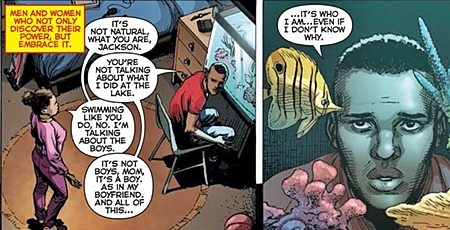
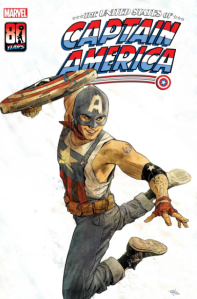
So while I’ve been churning out this series, Marvel made one big announcement that I have to include even though, technically, nothing has come to fruition yet. Apparently, this June, someone new will take on the title Captain America in a new series called United States of Captain America and this time it’s going to be gay teenager Aaron Fischer, a character created by Jan Bazaldua — one of only a handful of openly transgender creators at Marvel. This looks like they’re going to dive into a story about homeless queer youth — a really serious issue that has, to my knowledge, never really been address in comics before. It is an issue that primarily effects queer people of color, and it looks like Aaron’s white, but I guess we have to start somewhere? So, I do have high hopes for this and we’ll just have to see where that goes. But, I do think it’s a very cool full circle kind of moment to give the title to a gay guy, when that series was where Marvel first began giving our community any real representation way back with Arnie Roth in 1982.
So, now that you’re pretty much all caught up to where we are now….let’s talk about where we should go from here — in the hopes some head honcho from a major publishing company is reading this…. Here’s what I think needs to happen, and if you have your own ideas, tell me about them in a comment.
- Hire more transgender creators. Marvel has only ever had 7 openly transgender creators and 4 non-binary creators. DC has had one single non-binary creator, and also only 7 transgender staff members.
- Bring queer characters back from the dead. Everyone dies in comics, so I’m not going to complain about the number of queer characters who’ve died. However, there’s a saying I came across a lot while I researched this series: “The only people who stay dead in comics are Bucky, Jason Todd, and Uncle Ben.” But two of those people have come back from the dead. And you know who hasn’t? A long, long, long list of LGBTQ+ characters.
- But especially, DC, bring back Coagula or Lord Fanny. Or both. Don’t just ignore that before you reset continuity, you had some awesome trans superheroes and since you reset your continuity you have free reign to bring them back. (While we’re on the topic of bringing people back, bring back Fade too.)
- The vast majority of LGBTQ+ characters in comics are white, cisgender, and wealthy or at least middle class. There needs to be more diversity than that, there’s so many more stories to tell. I can’t stress this one enough.
- We need more human transgender, genderfluid, or non-binary characters. Like, there’s not that many out there already and a significant number of them are aliens or actual shapeshifters, or both. Just don’t name them Snowflake, and it’ll be fine.
- DC, you gotta give us a wedding between either Midnighter and Apollo (to get them back where they were) or Kate Kane and Maggie Sawyer (to make up for teasing us so!) One or the other. Or both. Just give us something.
- This might only be on my wishlist, but I’d love to see a mainstream publisher give us an all queer superhero team. Found families are such an important part of the queer community and queer experience, I’d love to see that reflected in comics.
Okay! Phew! We made it. This is the end. I don’t usually do this because it can make this blog, which is a hobby, feel like a job, but in case you want to look at some of the things I skipped over or breezed past without much detail, I’ll give you the main sources I used. Also the places where I snagged a lot of the images — usually I just do a Google image search and call it a day, but this series was way more work than I thought it was going to be. But also lots of fun, so it was worth it! Anyways, those sources are: Queer Comics History, Gay League, and Prism Comics. I also dipped into the Marvel Database and DC Database, mostly to confirm dates of issues of their comics. If you’re interested to know the pretty much complete list of every LGBTQ+ character that’s been in those company’s comics, they do have categories for those characters to make them easy to find. Here’s Marvel’s. Here’s DC’s.
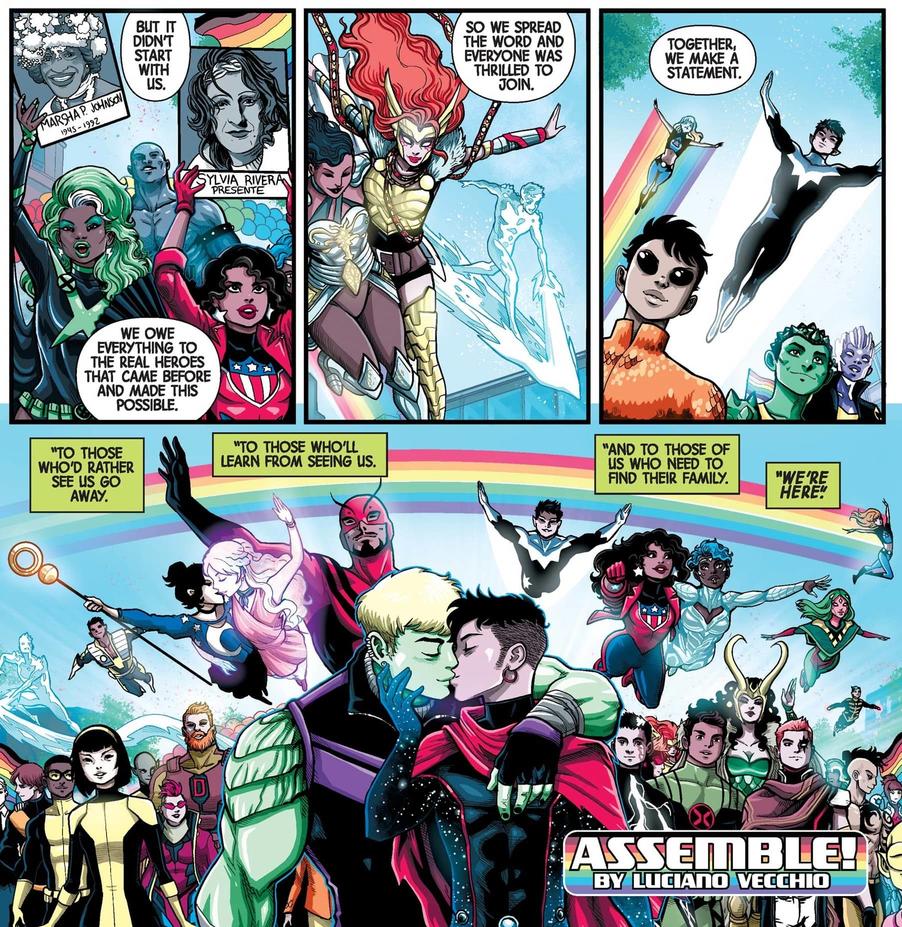
Anyways, we’ve come a really long way in comic books since characters were changing genders because they were bored on Mars. And that’s largely because of queer creators making their voices heard, even if they had to do it underground spaces. Now, with no Code and online distribution making it publishing even easier, I’m sure we have a lot more quality queer content on the way, and I for one can’t wait to read it.